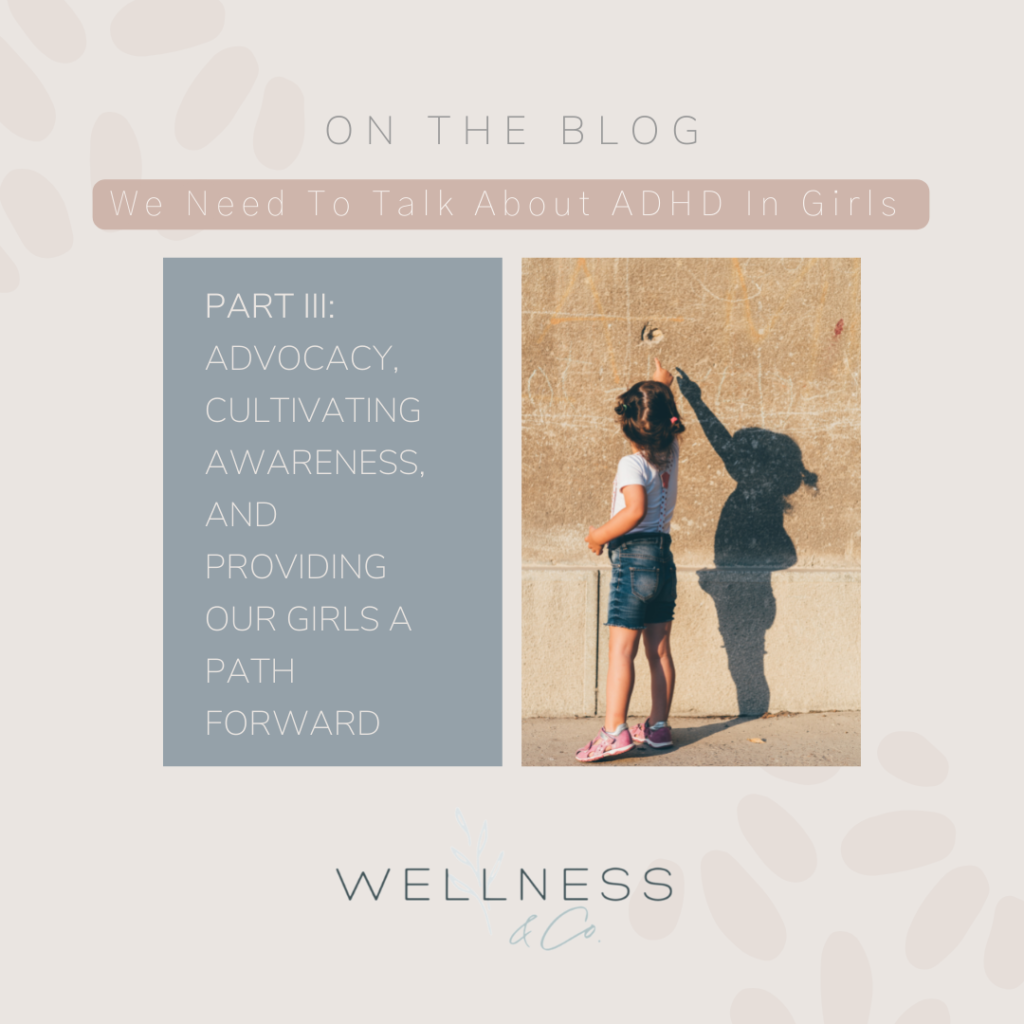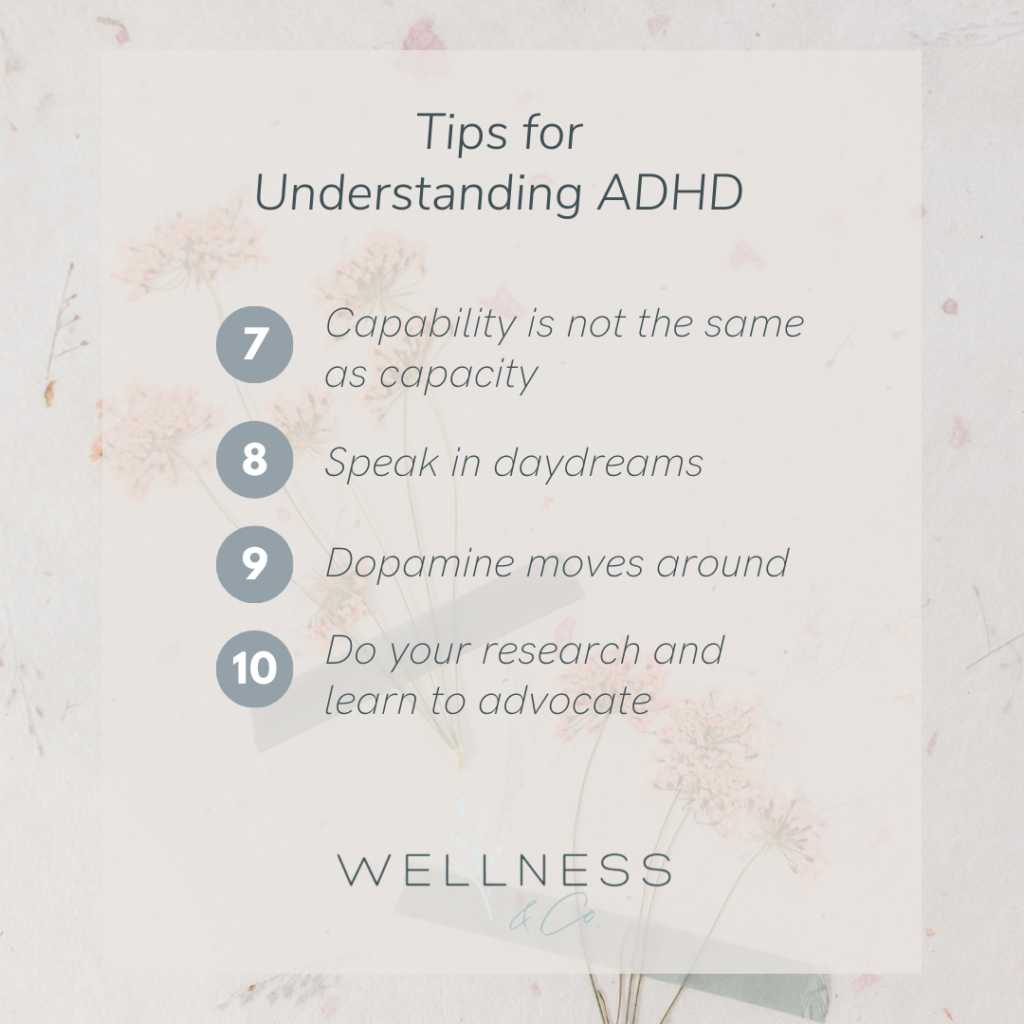Follow
Wellness & Co.
Hi, I'm Dr. K, Wellness & Co. is a growing therapy/coaching practice and educational hub for prospective clients based in Maryland and virtual clients all over the world!
Hi, I'm Dr. K
free guide
e -books
e -course
We Need To Talk About ADHD In Girls
October 22, 2024
Part III: Advocacy, Cultivating Awareness, and Providing Our Girls a Path Forward
By: Rebecca Horch, BACYC, CPC

You have made it to the final part of our series on ADHD in women and girls! If you have followed along thus far you will already have been given some valuable tips and tools on how to begin supporting those with ADHD in your life. For me, this final part is where it all ties together and we can begin to learn to take our knowledge and start really advocating for ourselves and the people we love around us.
To catch up, check Parts One and Two!
Enjoy!
My Story – How Personal Experience Led to Supporting Others
After graduation I started working with youth and families, and I’d often see a lot of my younger self in the youth on my caseload. The difference being that many of my youth didn’t have as many supportive adults around them. I saw them getting arrested, getting involved with local gang networks, being sexually exploited and getting kicked out of their homes. It was very different from my experience, but I had a sense that I connected to their stories on a deeper level.
Eventually I got married, and we started a family and my life became chaotic. All the challenges I had as a child and teen came roaring back, but this time I had twin newborns to keep alive on top of it. I was emotionally drowning, and had completely lost all sense of self. My inner anger (even rage), self doubt, shame, and seemingly incapability to “keep it together” came boiling to the surface. I went to my doctor, who diagnosed me with postpartum anxiety disorder and also referred me to a therapist. This particular therapist wasn’t the right fit for me, but it did give me a catalyst for finding the right one.
A few years went by, and I had another baby. I was still struggling, but because I was no longer working outside the home, I was managing to function enough to get through my days. Still, I seemed to again be in a situation where I didn’t quite fit in. I wasn’t like the other moms who knew how to plan playdates and have a meal schedule for their kids. I forgot to sign my kids up for preschool and by the time I got around it, they were all filled up. It felt like a constant reminder of my failures as a woman (which is another conversation about cultural and societal roles, but I digress). Other moms weren’t losing their keys 50 times a day, or putting the laundry in the dryer but forgetting to turn it on, or spending money on duplicates at the grocery store multiple times a week because they forgot they had the item at home already.
Motherhood, although I loved it, once again seemed to highlight to me that something was just different about the way I coped.
It was during this time that I found a counselor I connected with who just so happened to specialize in a condition I knew all about from the youth I had worked with before- Attention Deficit Hyperactivity Disorder, or ADHD. He was the one who helped me in my journey to understanding my daughter, and also the one who sparked my own curiosity about the possibility that I had ADHD myself.
After my own daughter’s diagnosis, which I spoke about in the last post, I started going to see my counselor more regularly, wondering if maybe he was onto something when he mentioned that typically there is a parent with ADHD as well. After some time, much research, and getting to know myself on a deeper level I decided to pursue a diagnosis. The assessments came back blaring for what’s known as “inattentive” type ADHD.
I decided I wanted to try the medication route, and the first time I took it, it was as though my brain came back online. I remember saying to my husband “people are this clear headed every single day?”
It was like freedom.
It took a while to find the dosage and family of medication that was the right fit for me, but ultimately medication was the right path for me. I still struggle with some executive functioning, and it’s taken me a long time to “unlearn” the shame that came with masking my symptoms for so many years. I’ve also learned to harness this difference in my brain to allow it to work for me, not against me (most of the time).

Your Daughter – Understanding the Broken System
Through my hyperfocus about needing to know all I could about ADHD, I quickly learned that more and more adult women were being diagnosed with ADHD because it was missed as children. Why? Because the majority of research around ADHD has been done on boys, and typically (not always), boys present differently than girls.
Most of the research focused on two things: hyperactivity and impulsivity. However, girls typically present more with symptoms of inattentiveness. All people with ADHD will have some qualities of the typical symptoms, however where a boy might present his hyperactivity as a need to move around and touch everything in sight, a girl will show that same hyperactiveness through excessive chatting, or getting lost in thoughts. Where a boy might be impulsive by taking toys away from friends, a girl will show impulsivity by saying something a bit insensitive to a friend without thinking. Girls also tend to quietly daydream while boys tend to be more overtly disruptive. You see, girls are underdiagnosed (and there is actually research to suggest that boys are over diagnosed) because their symptoms are more “socially acceptable” than how boys typically present.
Ultimately the brain is doing the same thing in both boys and girls: It is an inability to regulate a hormone called Dopamine.
Dopamine is a neurotransmitter that helps the nervous system send messages to different parts of your brain. It plays a role in how people feel pleasure as well as the ability to think, focus and plan. So, when your brain has a challenge with regulating this hormone (regulating being more accurate than deficit like the name suggests), it is going to desperately seek out any shred of dopamine it can, resulting in the symptoms associated with ADHD. The difference between genders simply comes in the typical strategies used to meet that dopamine requirement. Whether this is culturally ingrained, biologically ingrained or both I’m unsure. However, I do know that caregivers and providers understanding this information can make all the difference for the child.
So, while doing all this research, I noticed myself thinking: “So is the underlying reason girls are underdiagnosed because their symptoms are not affecting the quality of life of the people around them? Does the research point to the fact that the true concern is not actually for the child, but for the environment around the child?”
Feeling uncomfortable yet? That’s because when we are faced with the fact that the system has failed our children even at its most foundational level of research, it means we have some work to do.
When it comes to ADHD in girls, it is paramount that we as parents, caregivers, teachers, and mental health & medical providers understand that much of the language we’ve been given and the research that’s been done in this field is underfunded and misguided.
And our girls are suffering because of it.
When research’s hypothesis is focussed on how the environment is affected and not how the child is, we are taking an approach that says the child is a “clog in the well-oiled system.”
I can share from personal, professional and simply human experience that these kids are not clogs in a system. Because children are never clogs in the system. That’s a system problem not a person problem.
These kids simply have a brain that the system wasn’t thinking of when it was built. And that is the key: the system was built, meaning it can be taken down and rebuilt.
And that is where family, and all kinds of providers have the opportunity to step up. You have more leverage and power here than you know. Learning how to best support the girls in your life with ADHD so they can thrive in a world that doesn’t always understand their brain is a foundational step. Learning to help them harness their gifts of their brain will be the most powerful gift you can give them.
I feel empowered and lucky that we were able to understand ADHD early on for our daughter. I also feel a bit dejected and frustrated that it took so long for me. Thankfully research is just starting to recognize its pitfalls here, and hopefully there will be more accurate data out in the coming years. In the meantime, we have the ability to act as a catalyst for continued research by advocating for the young girls in our life. The more persistent we are, the more likely it is that this area of research will be studied as thoroughly as it needs to be.
I’d also like to add that research has lacked significantly between not only genders, but socioeconomic status, racial minorities, and cultures as well. This is important to know because it’s just more fuel to understand how much farther we have to go as advocates for the people in our lives.

Tips for Understanding ADHD:
If you are someone who knows a young girl or a woman in your life who has ADHD or you suspect has ADHD and you want to know some practical ways you can support them right now here is some basic education & strategies:
Tip Seven – Capability is not the same as Capacity
Just because you know this person is capable of something (and maybe has done it before) does not mean they have the capacity to do it. Remember if the dopamine is not present it can feel almost impossible. Imagine yourself standing at the start of a marathon being asked to run all those miles after not eating or sleeping for 3 days. This is what it can feel like in the ADHD brain even with the smallest tasks.
Tip Eight – Speak in daydreams
The creativity of women and girls when they daydream can be a powerful catalyst for relationship and connection. Enter into daydreams with them to build trust and secure attachment. This can be done through play, reading and writing, and even sharing your own daydreams and creating stories together.
Tip Nine – Dopamine moves around
A person may show intense interest in one activity or topic for a while and then that will expire and they’ll move on to something else. As best you can, follow the dopamine. Meaning work with/teach/practice skills with the person based off their current area of interest, and don’t be surprised when it changes.
Tip Ten – Do your research and learn to advocate
Read up! There isn’t as much research done for girls with ADHD specifically but it is out there. Learn to understand their brain so that you can advocate for them as needed and teach them how to advocate for themselves. Knowledge is power.
A Final Note:
If you have made it to the end of this series, a part of you may be feeling empowered while another part still has so many questions. That is good and ok!
ADHD, like most things in life, is not a clear cut diagnosis with one specific path forward. It will show up differently in every single human being because we are all unique and experience this life differently. ADHD in women specifically who were undiagnosed as children can also be comorbid (a fancy word for “at the same time”) with a number of other mental health challenges that were necessary to mask with in the world for so many years: anxiety, depression, learning disabilities, obsessive compulsive tendencies, eating disorders and symptoms of trauma among others can all be associated with ADHD.
This does not have to be a life sentence! In fact, it can be a life enhancer.
A true gift (yes- sometimes a frustrating gift, but a gift nonetheless!).
I encourage you to let your curiosity lead you. Reach out for help if you see yourself or your child in what you have read here. There are so many resources, and ways to support yourself. If you want to learn more, you can find me here. Let’s have a chat about your child, or if you have ADHD yourself, we can have a good laugh together at how we both left our phone in the refrigerator again.
All the best in your journey,
Rebecca
Rebecca strives to support others in building resilience, self-compassion, connected relationships and self-awareness. She loves to work with people who are ready for the hard work of inner growth and is passionate about helping others tap into their intuitive gifts and use them in this world.
Leave a Reply Cancel reply
CONTACT
Start Here
BLOG
OUR TEAM
SHOP
ABOUT
©2025 Wellness & Co. | All Rights Reserved | Design by EverMint Design Studio
BACK TO TOP
connect with us on instagram
